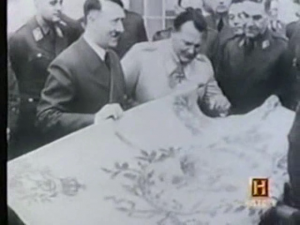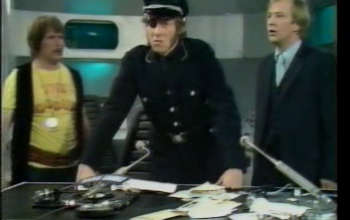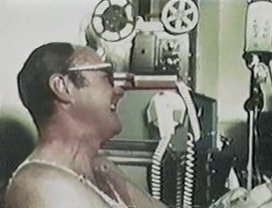In Search Of… S01E14 Nazi Plunder
It’s got Nazis, it’s got plunder, it’s got treasure hunting. Could be good? Let’s find out.

We open on a few minutes of WWII archive footage. It’s well-chosen footage and beautifully narrated. The TLDR of it is that the Nazis lost the war but didn’t have the good manners to put back the stuff they pinched. Then to the studio, where Nimoy talks with righteous relish of the decline of the Third Reich. He explains how senior Nazis like Martin Borman took off with stolen gold and artwork.
There’s a brief crappy re-enactment of a German car fleeing for safety, but it’s on one of those California roads like the ones they used in MASH, so it gives the surreal impression that the Nazis were escaping from Seoul or something. And we’re back to stock footage, this time of Hitler’s victorious tour of Paris. We’re told that Hitler ordered his army to plunder arts and bring them back to Germany. I’m wracking my memory to remember if this is correct. I know Goering stole a bunch of artworks, but I thought he did it behind Hitler’s back.
Eh, whatever. A bunch of artworks were stolen, with or without Adolf’s direct order. We’re shown footage that’s supposed to show Hitler and Goering examining art treasures, but one thing they’re looking at looks like fancy wallpaper, the other thing like a chessboard. We see Hitler looking around an art gallery, and we are visibly reminded that the Fuehrer had really lousy taste in art. Like, really bad.
Now we go to Neuschwanstein Castle, which we’re told is a fifteenth century castle. Only four centuries out. It was built in the nineteenth century. But they correctly name the builder as Ludwig II of Bavaria. They then rather unfairly compare ‘Mad’ King Ludwig to Hitler. Even though both of these people have been described as madmen, Ludwig was a much, much, much nicer person than Hitler.
Much.
Anyway, plundered art was stored here, during the war, old masters and ‘works of little merit’ all mixed in together when Neuschwanstein was captured by the allies.
Next up a salt mine where art was stored. Just like in that Bill Murray movie! There’s nothing there now, but the fimmakers intercut footage of the mine storage rooms with stills of old masters. It manages to be cheap and evocative at the same time, which is interesting.
We move on to an interview with Walter Horn, a German-born American art historian, and all around interesting person. Horn talks of his work recovering the Holy Roman Empire’s regalia and a fortune in gold coins–misappropriated by the Nazis, then taken from the salt mine by Martin Bormann’s right hand man. Then we’re specifically talking about Bormann’s escape, and Horn’s attempt to follow his tracks. Horn never found Bormann, but he did manage to get the missing coins back.
Horn is very charming, and his story of recovering Nazi gold is surprisingly… Polite, I guess? Civilised? It’s an interesting story, and I wish that he’d been given more screen time.
Now we go to a lake. How pretty! Now we’re onto stock footage of Jews being taken to concentration camps. Yeah, no jokes here. There’s a controlled but real anger in Nimoy’s voice. I seem to remember that he was Jewish? Yup, definitely no snark in this paragraph. Talk of gold fillings, Mengele, Nurenberg Trials.
Depressed now.
And we’re back to the pretty lake. Thank goodness! Austria’s Lake Toplitzee (thank you, Wikipedia article on ‘Lakes of Austria’ for spelling). Supposedly, there was Nazi gold hidden here. Some had been found, but people kept looking. Two treasure hunters had apparently gone missing, but no details are given. Instead, we see a couple of guys diving in the lake for treasure.
And now, finally, sixteen minutes in, the episode starts getting good and silly. Thank God! Up until here, the worst criticism I had has been ‘fact checking could have been better’. We get a crappy re-enactment of the two missing divers being shot by a mysterious figure armed with a rifle. ‘Some say’ that an underground Nazi movement was involved. Some say! Some!
The divers we saw earlier are not shot, and also do not find anything. But we’re still wondering if secret Nazis are keeping the secret of the lake. Okay, why not? There’s talk of secret hidden Nazi orders, and suddenly 1976 seems a lot nicer than now, when Nazi orders are neither secret or hidden.
Now I’m really depressed. I don’t watch this show to be depressed, damn it. I watch to be amused at crappy re-enactments of UFO sightings.
And we’re looking at Florence. Nimoy introduces us to Rudolfo Siviero, an Italian art historian who recovered many Italian masterpieces stolen by the Nazis. The film cuts in between Nazi documents and rescued artworks. Major Florentine galleries were refilled thanks to Siviero’s work. He also played a role in identifying fake masterpieces that proliferated after the war. There’s a slightly tortured argument that art is important because if we accept beauty we can reject the ugliness of war. And we’re done.
So a bit of an odd duck this week. A mostly decent, if under-fact checked WWII documentary, telling of one of the few times when art historians got to be completely badass. A mix of recounting the success stories in the hunt for looted art and the issues surrounding those pieces still missing. And a batshit tale of mysterious assassins guarding a lake. All in all not a bad episode, just not a memorable one.
Best quote
I’m going to skip best quote this week. A lot of interesting things said, but none framed in a particularly memorable way.
Summing up
WWII Newsreels: 8/10, Fact Checking: 5/10, Competent interviewee: 10/10, Cohesion: 7/10, Nimoyness: 8/10. Overall: 38/50 Distinction



